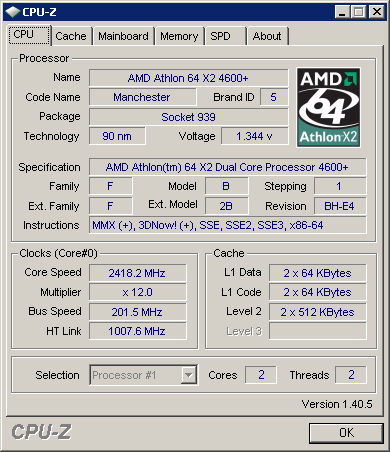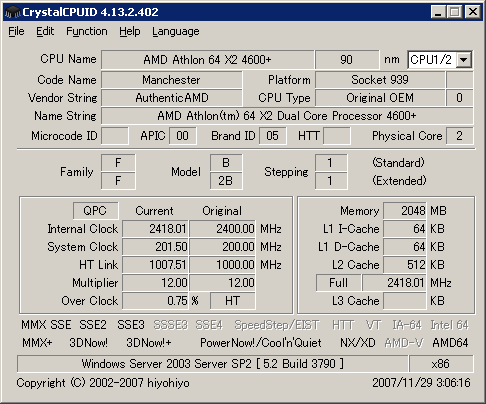Getting the Most Out Of Your Hardware: Motherboard/CPU Utility Roundup
by Ryan Smith on December 12, 2007 12:00 AM EST- Posted in
- Guides
Identification & Basic Information: CPU-Z & CrystalCPUID
Because motherboard tweaking should be handled in the otherwise feature-limited CMOS, we need tools beyond the CMOS to validate the operating state of a computer. There are many tools out there to do this, far more than we could cover in a single article, so we must whittle down the list. Over the years there are specific tools we have turned to often and have become essential in our work and personal needs; and these are our favorite tools.
We’ll start with the well known CPU-Z and CrystalCPUID, two utilities that cover the most basic of needs. Both tools are profilers, which are routinely used in basic identification of system components and discovering at what frequencies and what timings various motherboard components and the CPU are running at. They’re more akin to a surgical knife than a Swiss army knife, but they’re also the most essential of all the tools we work with, which is why we list them first.
The fundamental aspect of both programs is that they’re based around one of the x86 instructions, CPUID, which was originally intended to allow programmers to easily query the processor to see what features are supported, and has since then been expanded to other features. Although intended for programmer use, the information can be equally useful for users in the certain cases that these programs cover.

The most immediate value of both of these programs however is for their use in overclocking to determine what frequencies and timings the CPU and memory are running at. It’s a deceptively simple task but between thermal throttling, power optimization, and motherboards that will reset their settings if they think the computer is unstable, both make for highly effective tools in ensuring that an overclocked computer is running at what it should be. CPU-Z in particular also is one of the most accurate programs we have ever seen for reporting the core voltage of a CPU, which is important for determining what voltage a CPU is really running at since the voltage levels requested by the motherboard are seldom perfect, and doubly-important for Intel’s MCM 65nm Q-series processors, which suffer from very high levels of Vdroop.
The other major use for both of these programs, and what we believe is actually their most common use, is simple system and part identification. Both programs can read the CPUID information to determine the model of the processor in use, but they can also read information from the motherboard itself and the RAM. The functionality and accuracy is a little more limited here since most of this information is pulled verbatim from strings in the BIOS and RAM SPD chip, but this information is generally correct unless it’s coming from an OEM board.

Compared to CPU-Z, CrystalCPUID features a handful of additional features such as multiplier control (though we have a better suggestion for this feature later on), but in the same vein CPU-Z is a bit simpler, a bit more refined, and a bit easier to use and interpret as a result. Both however are shining examples of the kind of Spartan design and small file size we like to see out of motherboard utilities. Out of all of the utilities we’re looking at today, these are the simplest, but they’re also the best at their tasks.










11 Comments
View All Comments
jtleon - Wednesday, March 12, 2008 - link
I know that such a guide may be a common item online, however, those other sites that claim to "optimize" an OS install are not running your many benchmarks on hardware. I would greatly appreciate seeing a comprehensive OS install guide (covering XP, Vista, perhaps even older operating systems like W2K).Regards,
jtleon
rADo2 - Friday, December 21, 2007 - link
Lavalys Everest Ultimate is an excellent infotool, it can also output its info to Logitech G15 LCD panel and/or Vista sidebar:http://lavalys.com/products/overview.php?pid=3&...">http://lavalys.com/products/overview.php?pid=3&...
Arctucas - Friday, December 14, 2007 - link
I never have used nTune because so many users who have used it report that it causes more problems than it is worth.Zak - Saturday, December 15, 2007 - link
I never had any real problems with nTune, except the built in stress test is clearly meant as a joke. Any machine I tried it with would almost always pass the nTune stress test for 10 minutes and then fail/lock up/crash during first few seconds of 3DMark** or any other utility or game.However, there is an issue that makes nTune kind of useless for me: the video card fan control settings don't get saved with profiles so after reboot the the overclocked profile loads but the fan defaults to its slow speeds so the card will overheat and your machine will crash during a game very quickly unless you manually set the fan to higher speed in nTune every time. Kinda annoying... Is there a solution for that, by any chance?
Z.
xsilver - Thursday, December 13, 2007 - link
I for one am sick of mobo makers not making any progress in this customization / tweaking area.For manufactuers to stand out from one another they have resorted to crazy looking heatpipe NB heatsinks when they could go another route.
After having owned an abit s939 board I found its uguru tweaking options to be excellent and stable. Being able to change voltages/FSB while in windows *WITHOUT REBOOT* this was key.
I have no idea why this is no longer available on my asus p5k dlx mobo. It keeps wanting to reboot after I change anything and it doesnt stick when I use it.
I would have thought it be extremely convenient to have a pc boot at low/standard voltages/FSB but then crank it up to max fsb/voltage when encoding/gaming/folding etc.
I would not hesitate to buy abit again if other manufacturers dont implement this feature in future motherboards (too bad abit doesnt have much market penetration and is hard to get here in australia)
jojo4u - Wednesday, December 12, 2007 - link
The crowd at SPCR hails RMClock for it undervolting options since you can control each step of CnQ/EIST instead of a global VID.Regardging the that Tjunction:
Btw, there's a fact with Intel CPUs which is often overlooked. The DTS reports how much the temperature is away from the throttling point. This point is variable for desktop CPUs. On top of it, you cannot read this value out. So DTS readings from different CPUs are useless since CoreTemp assumes 85 degree celsius most Intel desktop CPUs.
If you own a desktop Intel CPU, I would have a goal of staying at least 10 degree away from the throttling temperature. The new CoreTemp can output this delta.
See also: http://www.alcpu.com/forums/viewtopic.php?t=247">http://www.alcpu.com/forums/viewtopic.php?t=247
Intel mobile CPUs just report the temperature as "near" 85 or 100 degree celsius.
The actual value of the throttling point (PROCHOT_L) for AMD CPUs remains a complete mystery to me and will be part of my next experimenting
(from http://www.silentpcreview.com/forums/viewtopic.php...">http://www.silentpcreview.com/forums/viewtopic.php...
LEKO - Wednesday, December 12, 2007 - link
Thanks for this ocncise article, it will helps me, but mostly friends in their overclocking journey.These articles becomes "reference" when we teach overclocking to someone.
domg - Wednesday, December 12, 2007 - link
RMClock is a great application, no doubts about that. However, because of the latest restrictions imposed by Microsoft, there is absolutely no way of loading the UNSIGNED driver used by RMClock into Vista x64 unless you manually boot into development mode (every time). I would have liked to see something in the article about this, since there are a great many people out there who have been forced to go without use of RMClock for this very reason. If you search, you'll find that you can disable mandatory driver signing by uninstalling four Windows updates (KB932596, KB938979, KB938194, KB941649) and using bcdedit.exe to disable driver integrity checks. However, this should not be necessary and it would be nice to see the developer get on track with this after several months of known incompatibility.nullpointerus - Wednesday, December 12, 2007 - link
From what I've read, you can sign your own drivers:http://www.hauppauge.co.uk/board/showpost.php?p=60...">http://www.hauppauge.co.uk/board/showpost.php?p=60...
goinginstyle - Wednesday, December 12, 2007 - link
"NVIDIA and now AMD are taking a stab at the issue, but it has yet to be enough. Both are quite capable of the task and we hope to one day see the motherboard situation rival that of the video card situation."Have you tried AMD's new AOD utility? It still has a few issues but addresses just about all of your concerns with the mb utilities plus adds a few features that are not on the video card tuners.